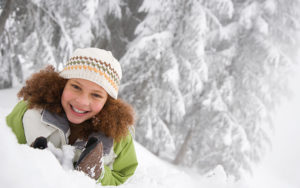
Proper safety is key to enjoying winter with your children
Winter means a break from bee stings, mosquito bites, pollen and poison ivy. But extreme cold comes with its own set of dangers.
To help parents steer their children safely through the winter, Asma Khan, DO, a pediatrician at OSF HealthCare Medical Group – Parkview in Rockford, has some helpful advice.
Dressing for winter? It’s all about the layers.
“A lot of people want to do just one big jacket and call it a day,” Dr. Khan said. “It’s just easier, and it seems like a big jacket would do the job best, right? But there are a couple reasons why using layers is best.”
For one, there is car seat safety. A bulky coat can prevent you from getting the safety straps fastened as securely as they should be.
You can avoid this problem by putting the coat on backwards over the straps. A blanket would work, too, she said.
Another benefit of layers? If one layer gets wet, the extra protection beneath helps prevent your child from getting too cold.
Of course, hats and gloves or mittens are essential. Children lose a lot of their heat through their head.
And don’t forget the sunscreen.
“It’s still important,” Dr. Khan said. “The sun’s still out there, it’s just deceiving because it’s not warm out.”
Keeping your baby warm
“For babies, sometimes we overdo it,” Dr. Khan said. “It can be tricky because babies can’t tell us if they’re too hot or too cold.”
To help with this issue, Dr. Khan suggests following this general rule of thumb: Whatever is comfortable for an adult (especially at home) – a baby should wear one more layer.
For the crib, blankets are a no-no, because a loose blanket is a danger for suffocation. Try using a fleece zip-up or footed pajamas to keep your baby warm, or use a swaddle blanket.
Be on the lookout
 Cold weather brings the danger of hypothermia and frostbite.
Cold weather brings the danger of hypothermia and frostbite.
Hypothermia occurs when a person’s body temperature sits below 95 degrees Fahrenheit for too long. It can happen if you’re outside too long or your clothes are wet, and children, who are smaller than adults and have less body fat, are at a higher risk.
If your child is shivering, looks sleepy or confused, their coordination is off or they have slurred or stuttering speech, get them evaluated right away. Call 9-1-1 if the symptoms progress, then remove their clothes and cover them with warm blankets, Dr. Khan said.
More common than hypothermia is frostbite, when thin layers of outer tissue freeze. It often occurs on the fingers, toes, ears and the tip of the nose.
Numbness, burning or looking really pale are all symptoms of frostbite, which can lead to blistering in the most severe cases. If your child is exhibiting any of these symptoms, bring them inside, remove their wet clothes and wrap them in blankets.
Don’t rub frostbitten areas, Dr. Khan said, because that just causes pain. Frostbite should resolve on its own, but if symptoms continue or worsen after a few minutes, seek medical treatment. The most severe cases can require amputation, so don’t ignore it.
Indoor safety
The cold winter months tend to drive us to spend more time indoors, in closer proximity to people, which makes it easier for viruses and bacteria to make the rounds. That’s why good hand-washing hygiene is important in the winter, according to Dr. Khan. Try to keep children from putting other children’s toys in their mouth. Clean toys well and often. Wash your own hands after cleaning up your child’s face, and keep sick children away from others as much as possible.
Other indoor winter safety tips:
- Check holiday decorations for fraying wires or bad connections that can catch fire.
- Never leave a room with lit candles – blow them out first.
- Put space heaters on elevated surfaces where children can’t reach them.
- Watch children to be sure they don’t get too near a fireplace with a lit fire, and keep the chimney clean so the fumes leave the house.
- Make sure you have a properly functioning carbon monoxide detector.
Be sure to contact your child’s pediatrician with any questions or concerns you have about keeping your child safe this winter.
Heading outdoors?
- Children just learning to walk should only be out for a short time.
- Children should dress appropriately and come inside to warm up periodically – preferably every 15 minutes or so – before heading back out.
- Children should not play near any snow plowing or snow blowing, to avoid accidents.
- Children should play as far as possible from roads to avoid any automobiles that might lose control.
- Adults should always watch over playing children. For teens, who don’t need parental supervision, a buddy system is wise so there is always help if something happens.
Going for a drive?
Be extra prepared with these items in your car in case you get stuck for a while.
- Snow brush and ice scraper
- Sand or cat litter to help your tires get traction and get unstuck
- First aid kit
- Blankets so you don’t freeze if you have to wait for help.
- Flashlights and batteries
- Snacks